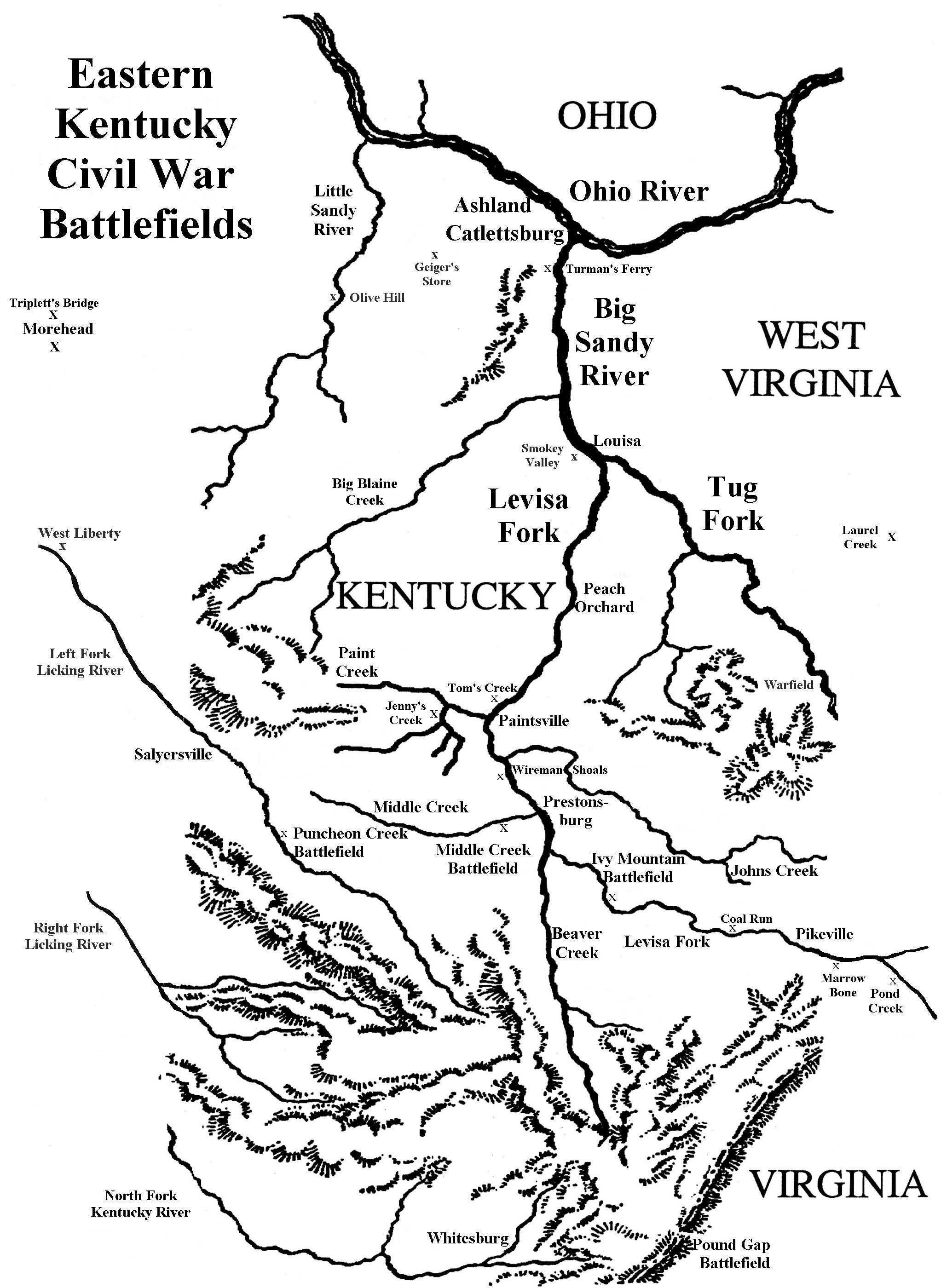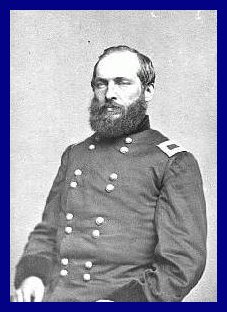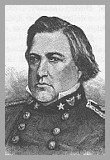 |
| Skirmish at West Liberty, October 23rd, 1861—Colonel L. A. Harris’ 2nd Ohio Infantry regiment and a company of Union cavalry, part of General “Bull” Nelson’s command, skirmish with Captain Jack May's much smaller Morgan Guards, driving them out of Morgan County and back to Prestonsburg. Battle of Ivy Mountain, November 8th, 1861—Led by Captain May, three companies of the newly-formed 5th Kentucky Infantry, C.S.A., fight a delaying action against four Union regiments led by General “Bull” Nelson, slowing their progress so that the main body of the 5th, under Colonel John S. Williams, can evacuate Pikeville and fall back to Pound Gap. Union losses are eight killed and twenty-four wounded. Confederate losses are ten killed and fifteen wounded. For more information, click here. Sill's Occupation of Pikeville, November 9th, 1861--With Metcalf's Kentucky horsemen leading the way, Colonel Joshua W. Sill and several companies of Kentucky and Ohio infantry come down Ferguson Creek and advance on Pikeville. Along the way they exchange fire with the Confederate horsemen who are reconnoitering their advance. When they reach the mouth of the creek, Metcalf's men dismount, climb the hills flanking the road, and fire upon the Confederate horsemen gathered in the town's main street. Then Sill brings up his artillery and shells them, causing them to retreat up the Shelby Creek road. One Union man is killed in the action, and two Confederates are wounded. "Troops are very hungry," Sill later reports. "All that we can get is beef. There is a mill near here, which we will set in motion to-day, and get plenty of corn meal." Skirmish at Tom’s Creek, January 4th, 1862—Nine hundred Union infantry under Colonel James A. Garfield, having marched up the Big Sandy from Catlettsburg, skirmish with one hundred Confederate cavalry sent on a scouting expedition by Marshall, whose command occupies a fortified position at Hager’s Farm near present-day Hager Hill, Kentucky. Skirmish at Jenny’s Creek, January 7th, 1862—Three hundred Union cavalry (the 2nd Virginia Cavalry under Colonel William Bolles) attack two hundred Confederate cavalry which Marshall has posted at Jenny’s Creek, several miles west of Paintsville, and drive them off. Six Confederates are killed and several wounded. Union casualties are two killed and one wounded. Battle of Middle Creek, January 10th, 1862—Eighteen hundred Union troops under Colonel James A. Garfield fight a day-long battle with 1,950 Confederates under General Humphrey Marshall. Garfield mounts several assaults and finally succeeds in driving one Confederate regiment from its entrenched position. When night falls, the Confederates retreat, burning some of their supplies and leaving their dead on the battlefield. Union casualties are three killed and eleven wounded. Confederate casualties are twelve killed and fourteen wounded. Garfield's Occupation of Pikeville, February 19th, 1862--With three Union regiments, Garfield takes possession of Pikeville and establishes his headquarters at Ratliff Tavern, located at the south end of the town's main street. A heavy rainfall on February 22nd causes the Levisa Fork to flood, and on the following day Garfield writes his wife: "The house where I am staying, which is sixty feet above the usual level of the river, is now surrounded. A wild river roars around it on all sides. Two large steamboats are up in the principal street of the village. Houses, stacks of wheat and hay, gigantic trees, saw-logs, fences, and all things that float are careening by with fearful velocity." Several days later Garfield receives word from the War Department that he has been promoted to Brigadier General. Since no superior officer is available, the swearing-in ceremony is conducted by Squire Charles, a local Justice of the Peace. Battle of Pound Gap, March 14th, 1862—Six hundred Federal infantry and one hundred cavalry led by Brigadier General Garfield attack the Confederate garrison at Pound Gap, consisting of five companies of Virginia State Militia under Major J. B. Thompson. After a twenty-minute fight, the rebels are routed and flee their fort, consisting of sixty log huts, commissary, hospital, and officers quarters. There are no Union casualties. Confederate casualties are seven killed and wounded. Menifee’s Raid on Pikeville, August 2nd thru 5th, 1862—Captain Nathaniel Menifee and his irregular band of Confederate guerrillas raid Pikeville, skirmishing several times with the town’s home guards. Nine Union men are killed and the rest are driven from the county. Menifee celebrates his victory by looting John Dils’s General Store, causing the proprietor, a well-known Union man, to flee for his life. The town’s stockyards are looted and a large number of cattle are driven back to Virginia. Marshall’s Invasion of Eastern Kentucky, September, 1862—Acting in concert with armies led by Kirby Smith and Braxton Bragg, Humphrey Marshall comes through Pound Gap with Col. Robert C.. Trigg’s 54th Virginia, Col. Alfred C. Moore’s 29th Virginia, Col. Campbell Slemp’s 64th Virginia, and Col. J. W. Gillespie’s 43rd Tennessee. Leading the van is Brig. Gen. John S. Williams’s 5th Kentucky Infantry. They occupy Pikeville, Prestonsburg, Salyersville, West Liberty and other towns along the Mount Sterling-Pound Gap Road. Following the Battle of Perryville (October 8th, 1862), Marshall moves his army back to their base in Southwestern Virginia. Battle of Wireman’s Shoals, December 4th, 1862—While escorting several pushboats filled with military supplies up the Big Sandy from the Union base at Catlettsburg to the Union outpost at Pikeville, Lt. Levi Hampton and a small detachment of the 39th Kentucky Infantry are attacked, surrounded, and captured by 800 Virginia Partisan Rangers under Colonel John N. Clarkson. Union losses are 2 killed, 12 wounded, and 38 captured. The Confederates capture 500 Enfield rifles, 7,000 rounds of ammunition, and enough uniforms to outfit Clarkson’s entire command. After Lt. Hampton surrenders, Clarkson’s men murder him and strip his body of its clothing. For more information, click here. Marshall’s Raid Through Eastern Kentucky, March-April, 1863—On March 15th, 1863, Marshall comes through Pound Gap with 1,800 mounted men, including Col. Henry Giltner’s 4th Kentucky, Col. Thomas Johnson’s 2nd Kentucky, Col. Ezekiel F. Clay’s 1st Kentucky, Col. Ben E. Caudill’s 11th Kentucky, and a squadron of men under Captain G. M. Jessee. He is later joined by Colonel Jack May and his newly-formed 10th Kentucky Cavalry. After dispersing a Union force that has been harassing Colonel Roy Cluke’s cavalry at Salyersville, Marshall marches to Louisa, intending to capture Fort Bishop, but when he and his officers arrive on the scene and discover how well-defended it is, they decide to change their plans. After this fiasco, they move through Breathitt, Wolfe, and Owsley counties, burning and plundering 43 Wolfe County and Owsley County farms before returning to their base in Southwestern Virginia. Skirmish at Smokey Valley, March 24th, 1863—Eighteen hundred Confederate cavalry led by Marshall attack a defensive position held by 300 mounted men of Col. George W. Gallup’s 14th Kentucky Mounted Infantry, forcing them to fall back to Fort Bishop, the Union supply depot at Louisa. Union losses are one killed, two wounded, and four missing. On the following day, after inspecting the fort’s defenses with his telescope, Marshall decides not to attack it. Everett’s Raid through Eastern Kentucky, June, 1863—Three hundred Confederate cavalry under Col. Peter Everett pass through Eastern Kentucky in order to attack the Union supply depot at Maysville, where, on June 14th, they capture 50 horses, 330 rifles, and 25 pistols. On the next day, near Olympian Springs in Bath County, they ambush Major R. T. Williams and thirty men of the 14th Kentucky Cavalry, killing eleven and capturing twelve. Battle of Triplett’s Bridge, June 16th, 1863—Two battalions of the 10th Kentucky Cavalry led by Lt. Col. R. R. Maltby overtake Everett’s command at Triplett’s Creek Bridge near Morehead in Rowan County. Maltby’s men surround the Confederates, defeat them, and take 38 prisoners. When DeCourcey’s 8th Michigan Cavalry arrives on the scene, mistaking Maltby’s men for the enemy, Evertt and the rest of his men slip away and return to their base in Russell County, Virginia. Battle of Turman’s Ferry, January 9th, 1864—While camped for the night in a schoolhouse near Turman’s Ferry on the Big Sandy River fourteen miles above Catlettsburg, 75 men of the 39th Kentucky Infantry are surrounded and attacked by 150 Confederate cavalry under Colonel M. J. Ferguson. Awakened from their sleep, the Kentuckians flee in panic, running barefoot into the snow and sub-zero weather. Fourteen are killed or wounded in the attack and many others suffer frostbite. Battle of Laurel Creek, February 15th, 1864—Colonel Gallup, leading 275 unmounted men of the 14th Kentucky Infantry and 150 mounted men of the 39th Kentucky Infantry, launch a surprise attack on Colonel M. J. Ferguson and his 16th Virginia Cavalry, camped at the mouth of Laurel Creek in WayneCounty, West Virginia. Ferguson is captured, along with his surgeon, two lieutenants, and 38 privates. Confederate losses are ten killed and several wounded. Sixteen Federal prisoners held by the Confederates are freed, along with a large number of horses. Clay’s Raid into Eastern Kentucky, March-April, 1864—Six hundred Confederate cavalry under Colonel Ezekiel F. Clay come through Pound Gap and march down the Big Sandy to Paintsville, where, on April 13th, they encounter four companies of Gallup’s 14th Kentucky Mounted Infantry and 500 home guards. When the rebels attack the Union position, they are repulsed, suffering two killed, two wounded, and seven captured. Clay then sends Gallup a flag of truce, asking for time to bury his dead and exhange prisoners. Judging Gallup’s force to be stronger than his own, Clay decides to retreat to Salyersville. Battle of Puncheon Creek (Half Mountain), April 14th, 1864—Colonel Gallup, leading the 14th Kentucky Mounted Infantry under Lt. Col. Joseph R. Brown and the 39th Kentucky Mounted Infantry under Col. David A Mims, a total of 800 men, launches a surprise attack on Colonel Clay’s 600 Confederate cavalry while they are camped at Half Mountain on the Licking River, three miles above Salyersville. A four-hour engagement ensues, during which Colonel Clay is wounded in the eye and captured. Confederate losses are 60 killed and wounded and 60 captured, along with 200 horses, 400 saddles, 300 small arms, and all their tents and equipage. Union losses are one killed and four wounded. Morgan’s Last Kentucky Raid, June 2nd-12th, 1864— Leading 1,400 cavalry and 800 dismounted men, Brig. Gen. John Hunt Morgan comes through Pound Gap, passes down Troublesome Creek, and raids Mount Sterling, capturing 380 Union soldiers. Brig. Gen. Stephen Burbridge is leading a large Federal force up the Big Sandy Valley, and the purpose of Morgan’s raid is to divert Burbridge from his objective, Preston’s Saltworks at Saltville, Virginia. At Mount Sterling Morgan’s men steal and plunder, taking $80,000 from the Farmer’s Branch Bank. Battle of Mount Sterling, June 9th, 1864—General Burbridge and his troopers make an extraordinary 90-mile march from the Forks of Beaver Creek to Mount Sterling, where they launch a surprise pre-dawn attack on Morgan’s dismounted men, trampling them as they are sleeping in their tents. A desperate fight ensues, and the Confederates are defeated. Confederate losses are 54 killed, 120 wounded, and 150 captured. Union losses are 8 killed, 20 wounded, and 50 missing. Battle of Cynthiana, June 12th, 1864—After raiding Lexington, where they capture 2,000 horses, Morgan and his men march to Cynthiana, where, on June 11th, they defeat and capture the town’s 400-man Union garrison. On the following day, lacking ammunition for their rifles, they are attacked and routed by Burbridge’s troopers, who capture their baggage train and send them fleeing in several directions. On their way back to Virginia, Morgan and some of his men pass through Prestonsburg, where Morgan rests his mount and spends a pleasant hour drinking a glass of water and chatting with local ladies on the porch of the John Graham Johns House. |
 |
| Captain Jack May |
 |
| General William "Bull" Nelson |
 |
| Colonel James A. Garfield |
 |
| General Humphrey Marshall |
 |
| General John S. Williams |
 |
| Colonel George W. Gallup |
| Colonel Ezekiel F. Clay |
 |
| General John Hunt Morgan |
 |
| General Stephen Burbridge |
 |
| John Dils, Jr. |
 |
| Colonel Ben E. Caudill |
 |
| Colonel David A. Mims |
 |
| Colonel Joshua Woodrow Sill |
 |
| Colonel Alfred Cleon Moore |
 |